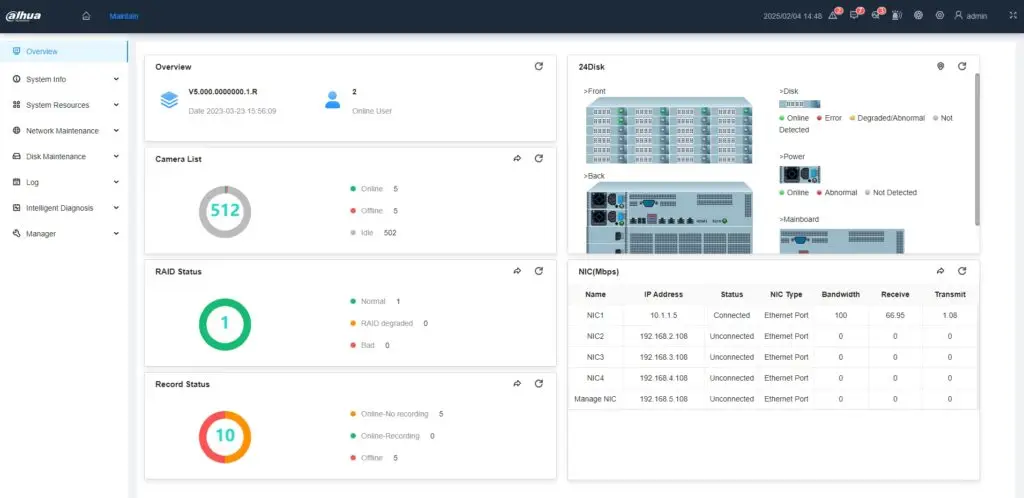
Data security and availability are critical aspects of modern surveillance systems. In this blog, we explore five top backup solutions tailored for Dahua devices:
These options cater to industries like finance, retail, healthcare, education, and manufacturing, ensuring secure and reliable data storage across diverse applications. These systems play a vital role across industries such as finance, where they safeguard transaction environments; retail, where they prevent theft and ensure customer safety; manufacturing, where they monitor operations and ensure compliance; healthcare, where they ensure patient and staff safety; and education, where they secure campuses and safeguard learning environments. As a leader in security technology, Dahua offers versatile backup solutions to ensure that your recordings are safe and accessible. Whether you’re looking to integrate a secondary recorder, leverage cloud storage, or use advanced network storage, this guide will walk you through the top five Dahua backup solutions, tailored to different budgets and application scenarios.

Adding a secondary recorder is one of the simplest ways to create a reliable backup system. With this setup, the secondary device ensures no data is lost if the primary device fails. Here are some common configurations:
This setup is ideal for localized backup and ensures quick recovery in case of hardware failure. The user pays once for the hardware; the only ongoing costs are maintaining network links or keeping the internet on. However, this solution is limited to the hardware at the secondary location unless the user upgrades this hardware.
This option is best suited for:
Dahua Network Storage integrated with DSS (Dahua Security Software) provides a robust solution for businesses handling high volumes of surveillance data. This option, along with Options 1, 2, and 5, allows users to use the manufacturer’s native software for backup. This, in turn, provides advanced features like AI and analytics, making data retrieval, incident search, and reporting faster and more efficient. This setup is particularly advantageous for industries such as banks and financial institutions that need to securely store large amounts of transaction footage, as well as large retail chains requiring comprehensive surveillance for multiple outlets. DSS offers centralized management, and when paired with Dahua’s network storage, you can:
This solution is scalable and works well for medium to large enterprises. Similar to Option 1, the user pays once for the hardware, and the ongoing costs involve maintaining network connectivity or internet access. However, the solution’s capacity is limited to the hardware unless an upgrade is made.
This option is ideal for:

The File Transfer Protocol (FTP) is a simple yet effective way to store backups in the cloud. However, users will need third-party software to retrieve and playback the footage, as native playback is not supported through this method. Popular FTP service providers in Kenya and East Africa include Safaricom Cloud, MTN Cloud, and Liquid Telecom FTP services. For example, a retail business in Nairobi recently implemented Liquid Telecom FTP to maintain off-site backups, allowing for cost-effective storage and improved data safety. Such implementations demonstrate how local businesses are successfully leveraging these services for scalable and secure backup solutions. These localized options allow businesses to choose providers that understand regional needs while offering reliable service. Dahua devices support FTP backups, enabling you to transfer video recordings to an off-site server. Here’s how you can set it up:
This method is cost-effective and works well for small businesses or personal use. However, users must pay the third-party provider for services used and still cover running costs. The solution is scalable and can be expanded based on the user’s preferences.
This solution works well for:
For those looking to leverage public cloud infrastructure, Dahua offers the ability to back up data to online virtual machines (VMs) and network disks. This method provides:
Popular public cloud services such as AWS, Microsoft Azure, and Google Cloud can be used to set up your online VM and network disk for seamless backup operations. For instance, a Kenyan retail chain implemented Azure’s scalable storage to manage video data from multiple outlets, ensuring reliable backups and centralized management. This setup resulted in significant cost savings by eliminating the need for additional on-premises hardware while also improving efficiency through centralized access to footage and seamless scalability to meet growing data needs. This setup resulted in significant cost savings by eliminating the need for additional on-premises hardware while also improving efficiency through centralized access to footage and seamless scalability to meet growing data needs. This demonstrates the practicality of such services in industries that prioritize scalability and efficiency. These services are particularly well-suited for industries like healthcare, where secure and compliant data storage is critical, and education, where scalable storage solutions are essential for managing extensive video footage across campuses. Like FTP, users will need to pay third-party providers and cover running costs. This solution is highly scalable and can grow with your needs.
This option is most suitable for:
Dahua Cloud Backup is an upcoming feature that promises to revolutionize surveillance data storage. Unlike existing cloud options, this solution is designed with seamless integration into the Dahua ecosystem, offering users specialized benefits such as AI-driven analytics, advanced data encryption, and real-time synchronization. These unique advantages make it a tailored choice for businesses prioritizing security and efficiency in surveillance backups. Unlike existing solutions, this service will offer effortless integration with Dahua devices, advanced data encryption for secure cloud storage, and seamless synchronization across devices. Its native design within the Dahua ecosystem ensures users can access specialized features like AI-driven analytics and rapid data retrieval, making it a more robust and user-friendly solution compared to third-party options. With these benefits, it stands out as a tailored solution for businesses requiring reliable, secure, and scalable cloud storage. This solution will offer:
This solution is projected to be hosted on Dolynk Cloud, making it a practical and native option for Dahua users. It will provide a more robust and specialized cloud backup solution. Stay tuned for more updates as Dahua continues to expand its cloud ecosystem.
This futuristic solution will likely benefit:
When choosing a backup solution, consider:
For any backup solution to work effectively, there must be local recording in place. This can include:
A reliable backup strategy is essential for protecting surveillance data, ensuring that even in the face of hardware failures or disasters, your critical recordings remain intact. With Dahua’s comprehensive range of solutions, you can choose a backup method that best suits your needs—whether it’s local storage, FTP (requiring third-party software for playback), public cloud, or the upcoming Dahua Cloud Backup. Each option comes with unique features to cater to various industries like finance, retail, Jua Kali, healthcare, and education. Reach out for guidance on selecting the best fit for your needs:
Let us know your preferred backup solution or share your experiences in the comments! With Dahua’s innovations, your surveillance system is in safe hands, ready to meet the demands of Kenya, East Africa, and the world.

1 Comment
mwandothebossFebruary 4, 2025
Insightful